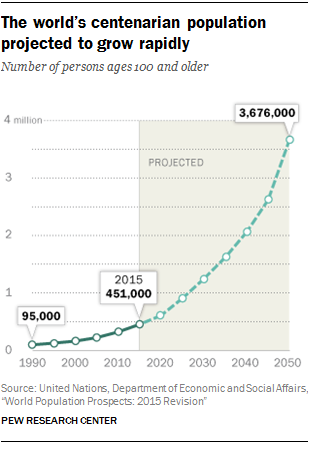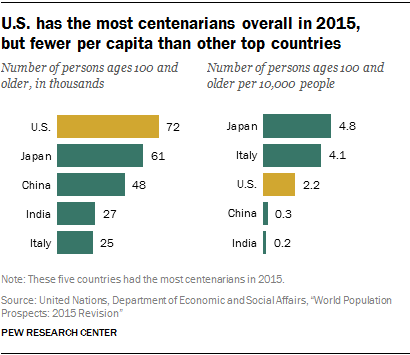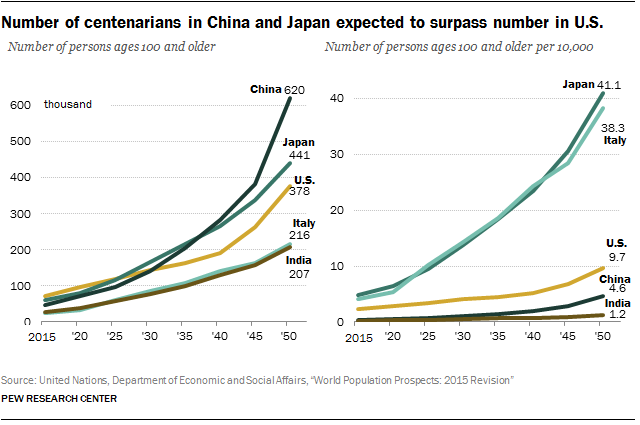Note: A new version of this post from 2024 provides updated and expanded projections on the global centenarian population.

The world was home to nearly half a million centenarians (people ages 100 and older) in 2015, more than four times as many as in 1990, according to United Nations estimates. And this growth is expected to accelerate: Projections suggest there will be 3.7 million centenarians across the globe in 2050.
While centenarians make up a small share of the world’s older population, their proportion is growing. In 1990 there were 2.9 centenarians for every 10,000 adults ages 65 and older around the world. That share grew to 7.4 by 2015 and is projected to rise to 23.6 by 2050.
Since 1990, the population of those ages 80 and older – the oldest segments of the 65-plus population – has grown more rapidly than that of the younger segments, those ages 65-79. This faster growth is driven by improved life expectancies among those 65 and older.

Estimates of the centenarian population can be hard to come by due to misreporting and data processing issues. It is often difficult to verify the ages reported, as centenarians might not have birth records to confirm their age. But the available data suggest that the U.S. leads the world in terms of the sheer number of centenarians, followed by Japan, China, India and Italy.
China and India make the list mainly because of their large populations. Currently centenarians make up a very small share, proportionally, of these relatively young countries. But they make up a larger share of the total populations of rapidly aging Japan and Italy. Today, there are 4.8 centenarians for every 10,000 people in Japan and 4.1 in Italy.
By comparison, in the U.S. – which is aging at a slower rate than Japan and Italy, partly due to its higher fertility and immigration rates – there are now 2.2 centenarians per 10,000 people.
By 2050, China is expected to have the largest centenarian population, followed by Japan, the U.S., Italy and India, which will also remain in the top five.

Japan and Italy will have the highest proportion of centenarians to the total population. But among these top five centenarian countries, the centenarian share will grow fastest in China, where the population is expected to age rapidly in coming decades. By 2050, there will be 4.6 centenarians per 10,000 people in China, 13 times today’s very small share. In Japan and Italy, the proportion of centenarians to the total population will increase ninefold to 41.1 and 38.3 centenarians per 10,000 people, respectively.
The centenarian share of the populations of the U.S. and India will grow less rapidly. There will be 9.7 centenarians per 10,000 people in the U.S. and 1.2 in India by 2050. Overall the populations of these two countries will be relatively younger than China, Japan and Italy by 2050.